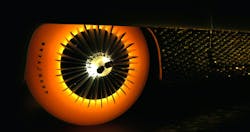When the day comes that autonomous, flying cars are the norm, Goodyear Tire & Rubber Co. will have the tires. The Aero concept tires of today will fit George Jetson’s flying car of the future.
The tire maker unveiled its latest concept tires at the 2019 Geneva International Motor Show, calling the Aero a “two-in-one tire designed for the autonomous, flying cars of the future. This concept would work both as a tire for driving on the road and a propeller for flying through the sky.” And while the Aero is definitely a concept tire, Goodyear says some of its technologies, such as its non-pneumatic structure and intelligent tire properties, are under development. Others could be the basis for new ideas and future products.
“Goodyear’s concepts are meant to trigger a debate on the tires and transport technologies for a new mobility ecosystem,” the company says.
Here’s a rundown of the technology in the Aero:
Multimodal design: The Aero is a multimodal tilt-rotor concept. It would serve as a drive train to transfer and absorb forces to and from the road in a traditional orientation and an aircraft propulsion system to provide lift in another orientation. With capable vehicles, the tire would give future commuters the freedom to move seamlessly from the road to the sky.
Non-pneumatic structure: The concept’s spokes would provide support to carry the weight of the vehicle, and also act as fan blades to provide lift when the tire is tilted. The airless tire uses a non-pneumatic structure that's flexible enough to dampen shocks when driving on the road, and strong enough to rotate at the high speeds necessary for the rotors to create vertical lift.
Magnetic propulsion: The Aero concept would use magnetic force to provide frictionless propulsion. This would enable the high rotating speeds required to drive the vehicle on the ground and, when the wheel is tilted, lift a vehicle into the air and propel it forward.
Optical sensing: The concept tire would use light-based, fiber optic sensors to monitor road conditions, tire wear and the structural integrity of the tire itself.
Artificial intelligence: The concept would also feature an embedded A.I. processor that would combine information from the tire’s sensors with data from vehicle-to-vehicle and vehicle-to-infrastructure communication. The A.I. processor would analyze these streams of data to recommend a course of action — allowing a vehicle to adapt to a flying or driving mode — and identify and resolve potential tire-related issues before they happen. An autonomous classic is reborn
In addition to the concept tire, Goodyear unveiled a new, old look in Geneva. The tire company unveiled a restored Golden Sahara II — fitted with a new set of translucent, glowing Goodyear tires.
The Golden Sahara II was developed by Jim Street and custom car designer George Barris in the 1950s. It’s considered one of the first concept autonomous vehicles, and it was a platform to test new electronics systems. Its tires were created using Neothane, a translucent synthetic rubber, and they contained internal lighting, which allowed them to glow. Goodyear was studying whether tires could help improve visibility in poor weather, or be designed to light up when the driver applied the brakes.
“In its heyday, the Golden Sahara II toured the United States” and was featured on television and in films. “It then sat in a garage for the best part of 50 years until Klairmont Kollections purchased the vehicle from Mecum Auctions in May 2018. The Golden Sahara II was restored with the help of Speakeasy Customs and Classics in Chicago and was presented at Geneva on four, newly-built Goodyear translucent tires.” Henry Dumortier, vice president of consumer tires for Goodyear Europe, says, “Discovery and innovation continue to be the core of what Goodyear does. Working on projects like the Golden Sahara II and the concept tires that we present at Geneva is an opportunity to stretch our imagination and envision the possible products and services of the future.”
Ultra-ultra-high performance tires Goodyear also shined the spotlight on its ultra-ultra-high performance (UUHP) tires in Geneva. Meet the SuperSport range. Goodyear says the tires feature innovative technologies and compounds to significantly improve braking distances and lap times “without neglecting more intangible elements of the driving experience, such as feedback during turn-in, under braking and approaching breakaway.”
The Eagle F1 SuperSport features stiff tread ribs for responsive directional changes, while a massive closed outside pattern on the tire’s shoulder provides control during load transfers in corners. A super-stiff sidewall design further improves handling without compromising ride comfort. Although primarily developed for dry conditions, Goodyear has addressed wet performance with a multi-compound combination that sees dry-optimized outer sections paired with three wet-optimized central segments.
The Eagle F1 SuperSport R increases grip levels and steering precision on and off track. A high-friction compound provides exceptional dry grip levels, while cornering stability comes from bridges in the tread pattern’s inner groove. Steering precision and feedback have also been further enhanced by optimizing the tire’s footprint for more consistent pressure distribution.
The Eagle F1 SuperSport RS is Goodyear’s most race-focused tire, designed to push the limit on the track while remaining road legal. The highly specialized racing-originated compound provides grip and performance levels in dry conditions.



